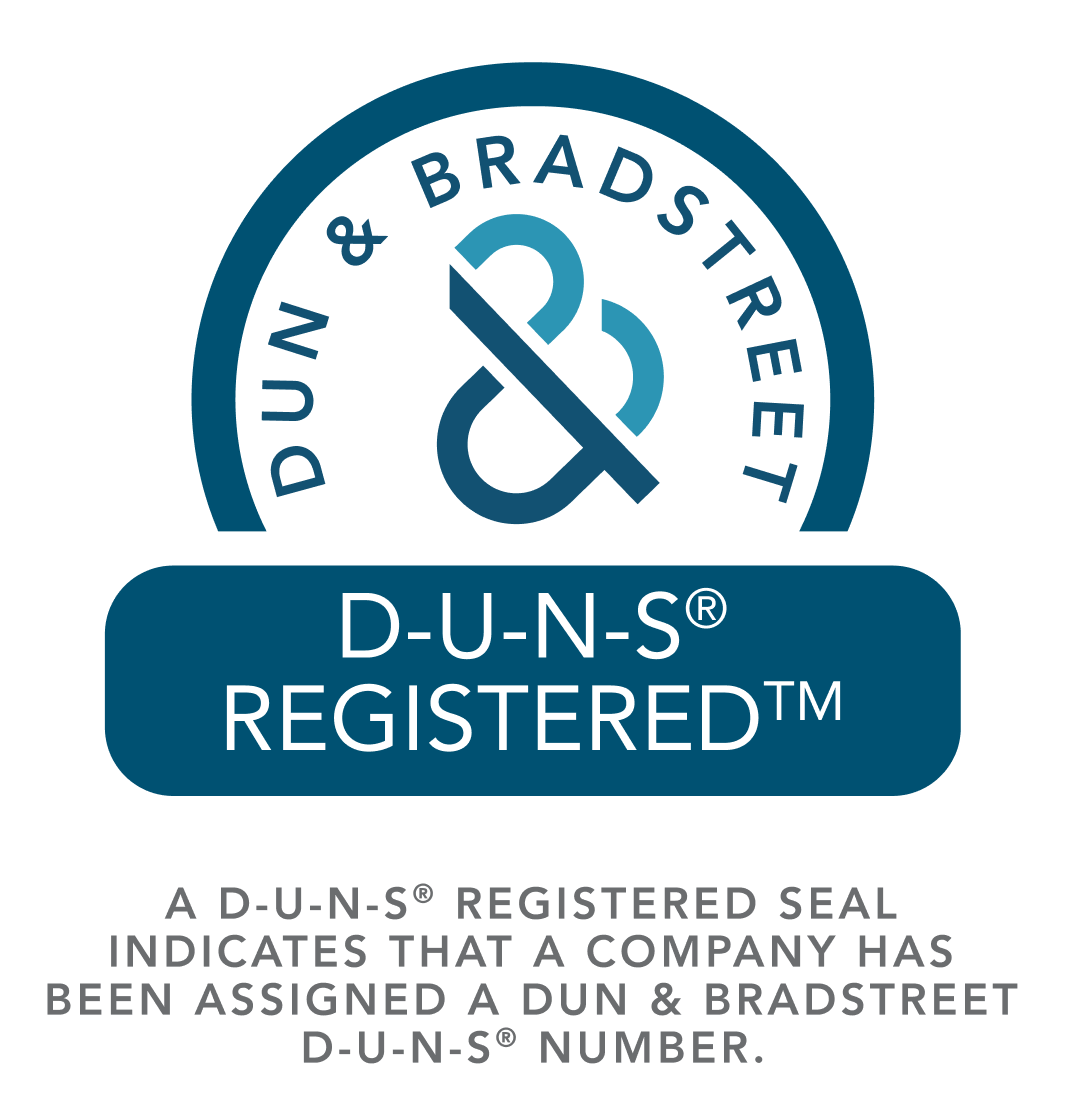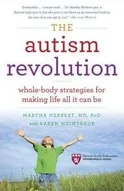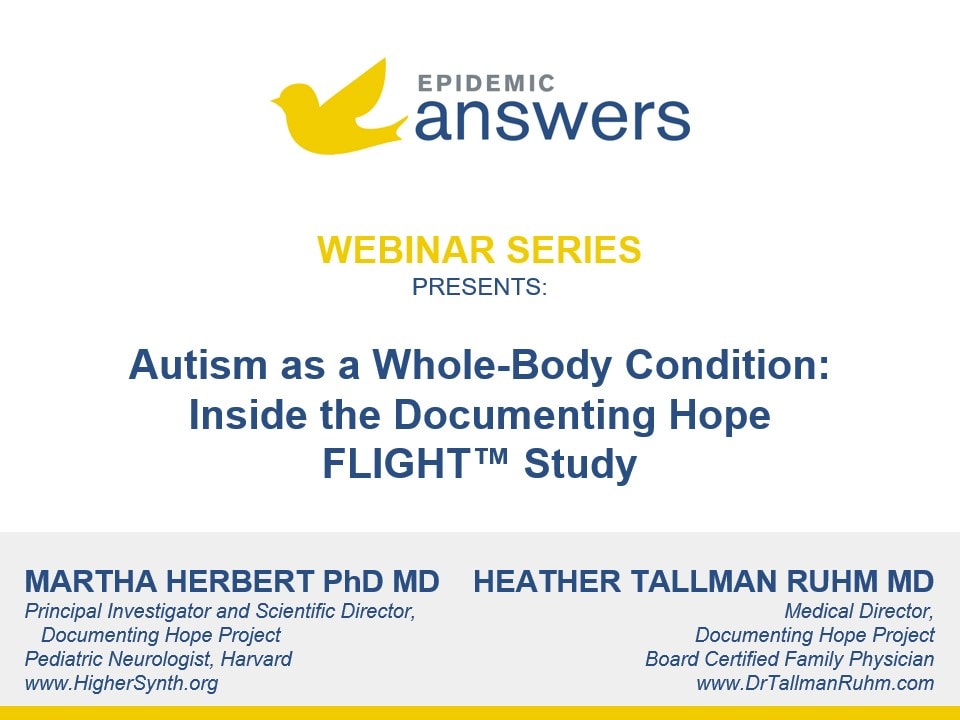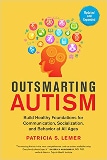Systems-Biology Perspective
For a child with autism, the total load of stressors on the body and brain often reaches a tipping point somewhere between the ages of 18 months and four years of age. However, there were often multiple red flags that were typically overlooked or dismissed before this time such as colic, allergies, eczema, chronic ear infections, developmental delays, seizures and chronic constipation or diarrhea. Seen individually, these symptoms appear to be typical childhood ailments. Seen from a whole-body approach, they tell a different story.
The Autism Revolution looks at autism from a systems-biology perspective, meaning that there is a web of influences on and within the body to produce a diagnosis of autism, which is typically never the same from person to person. When looked at this way, one may see that the “whole-body system (of a person with autism) may be be so overloaded that it has less bandwidth for handling” sensory stimulation, toxic exposures, immune exposures and other stressors.
In this book, Dr. Herbert discusses the following parts of the web that typically affect a child with autism:
- Genes and environment
- Cell problems
- Body health problems
- Brain health problems
- Brain processing problems
- Thinking, feeling and attending problems
- Communicating and relating problems
- Blockages to creativity and transcendance
By untangling these different threads of the web, obstacles to healing can be removed, allowing the body and brain to heal.
The Key to Healing
The key to overcoming many of the whole-body challenges of autism is to make the brain healthier by making the body healthier. Dr. Herbert believes that “small adjustments can sometimes trigger big changes” and that changing the diet is the best first step to take. Other than this first step, the book is not so much a step-by-step guide for improving your child’s health but rather a framework for assessing potential treatments and therapies that you can discuss with your child’s practitioner.
By removing these total-load stressors and adding in supports, symptoms of gastrointestinal, neurological, behavioral, immunological and other types of symptoms will often resolve, allowing these children to display their extraordinary gifts.
Conclusion
Although the book is packed with cutting-edge research and knowledge, Herbert and Weintraub do an excellent job of making the information and ideas accessible to both lay people and practitioners alike. The stories of the same few children are woven in and out of the narrative again and again to illustrate points as well as to personalize their stories and make them more relatable. Those who wish to understand the biomedical, whole-body approach to autism should read this essential book.
About Martha Herbert PhD MD
Martha Reed Herbert PhD MD is the Principal Investigator and Scientific Director of Epidemic Answers’ Documenting Hope Project.
She is a pediatric neurologist, neuroscientist, systems thinker and writer who trained in medicine at Columbia University, Pediatrics at Cornell-New York Hospital and Neurology at the Massachusetts General Hospital, Harvard Medical School.
At Harvard, she founded the collaborative multidisciplinary TRANSCEND Research Program which takes a whole-body-brain approach to challenged brain development.

Prior to her medical training she received her PhD in the History of Consciousness at the University of California, Santa Cruz, writing her dissertation on the evolution and development of learning processes.
She founded the Higher Synthesis Foundation in Cambridge, Massachusetts, whose mission is to study and inspire successful regenerative approaches to complex health and environmental problems, particularly those that fall under the umbrella of its “Gifted Clinicians, Transformative Treatments, Sensitive Measures” Project and her Body-Brain-World thematic.
She is the author of the book The Autism Revolution: Whole Body Strategies for Making Life All It Can Be as well as many scientific papers. Her websites are: drmarthaherbert.com and highersynthesisfoundation.org
About Karen Weintraub

A longtime newspaper journalist, Karen Weintraub is now a freelance writer, journalism professor and book author. Her first book, The Autism Revolution, with Harvard autism expert Dr. Martha Herbert, was published in April 2012, by Random House.
Her second, Fast Minds: How to Thrive If You Have ADHD (Or Think You Might), with Drs. Craig Surman and Tim Bilkey, was published in February 2013.
Her journalism has appeared in a range of publications and websites, including The Boston Globe, USA Today, the BBC online and Nature. She teaches at the Harvard Extension School and Boston University’s Graduate Program in Science Journalism. You can find out more about her at her website KarenWeintraub.com
Still Looking for Answers?
Visit the Epidemic Answers Practitioner Directory to find a practitioner near you.
Join us inside our online membership community for parents, Healing Together, where you’ll find even more healing resources, expert guidance, and a community to support you every step of your child’s healing journey.
Sources & References
Adams, J.B., et al. Comprehensive Nutritional and Dietary Intervention for Autism Spectrum Disorder-A Randomized, Controlled 12-Month Trial. Nutrients. 2018 Mar 17;10(3).
Adams, J.B., et al. Effect of a vitamin/mineral supplement on children and adults with autism. BMC Pediatr. 2011;11:111.
Adams, J.B., et al. Mercury in first-cut baby hair of children with autism versus typically-developing children. Toxicological & Environmental Chemistry. 2007 Jun;70(12):1046-51.
Adams, J.B., et al. Mercury, Lead, and Zinc in Baby Teeth of Children with Autism Versus Controls. Journal of Toxicology and Environmental Health. 2007 Jun;70(12):1046-51.
Adams, J.B., et al. Nutritional and metabolic status of children with autism vs. neurotypical children, and the association with autism severity. Nutr Metab (Lond). 2011 Jun 8;8(1):34.
Alabdali, A., et al. A key role for an impaired detoxification mechanism in the etiology and severity of autism spectrum disorders. Behav Brain Funct. 2014;10:14.
Alabdali, A., et al. Association of social and cognitive impairment and biomarkers in autism spectrum disorders. J Neuroinflammation. 2014;11:4.
Ashraghi, R.S., et al. Early Disruption of the Microbiome Leading to Decreased Antioxidant Capacity and Epigenetic Changes: Implications for the Rise in Autism. Front. Cell. Neurosci., 15 Aug 2018.
Ashwood, P., et al. Elevated plasma cytokines in autism spectrum disorders provide evidence of immune dysfunction and are associated with impaired behavioral outcome. Brain Behav Immun. 2011 Jan;25(1):40-5.
Ashwood, P., et al. The immune response in autism: a new frontier for autism research. Journal of Leukocyte Biology.2006 Jul;80(1):1-15.
Atladóttir, H.Ó., et al. Association of family history of autoimmune diseases and autism spectrum disorders. Pediatrics. 2009 Aug;124(2):687-94.
Atladóttir, H.Ó., et al. Autism after infection, febrile episodes, and antibiotic use during pregnancy: an exploratory study. Pediatrics. 2012 Dec;130(6):e1447-54.
Baker, S. Canaries and Miners. Alternative Therapies in Health and Medicine. Nov-Dec 2008;14(6):24-6.
Barrett, B. Substantial lifelong cost of autism spectrum disorder. J Pediatr. 2014;165(5):1068-9
Bateman, C. Autism–mitigating a global epidemic. S Afr Med J. 2013;103(5):276-7
Bitsika, V., et al. Hypothalamus-pituitary-adrenal axis daily fluctuation, anxiety and age interact to predict cortisol concentrations in boys with an autism spectrum disorder. Physiol Behav. 2015;138:200-7
Blaylock, R.L. A possible central mechanism in autism spectrum disorders, part 1. Altern Ther Health Med. 2008 Nov-Dec;14(6):46-53.
Blaylock, R.L. A possible central mechanism in autism spectrum disorders, part 2: immunoexcitotoxicity. Altern Ther Health Med. 2009 Jan-Feb;15(1):60-7.
Blaylock, R.L. A possible central mechanism in autism spectrum disorders, part 3: the role of excitotoxin food additives and the synergistic effects of other environmental toxins. Altern Ther Health Med. 2009 Mar-Apr;15(2):56-60.
Blaylock, R.L., et al. Immune-glutamatergic dysfunction as a central mechanism of the autism spectrum disorders. Curr Med Chem. 2009;16(2):157-70.
Borre, Y.E., et al. Microbiota and neurodevelopmental windows: implications for brain disorders. Trends Mol Med. 2014 Sep;20(9):509-18.
Bouder, et al. Brief report: Quantifying the impact of autism coverage on private insurance premiums. J Autism Dev Disord. 2009;39(6):953-7
Bradstreet, et al. Biomarker-guided interventions of clinically relevant conditions associated with autism spectrum disorders and attention deficit hyperactivity disorder. Altern Med Rev. 2010;15(1):15-32
Bransfield, R.C., et al. The association between tick-borne infections, Lyme borreliosis and autism spectrum disorders. Medical Hypotheses. 2008;70(5):967-74.
Brown, et al. Observable essential fatty acid deficiency markers and autism spectrum disorder. Breastfeed Rev. 2014;22(2):21-6.
Buescher, et al. Costs of autism spectrum disorders in the United Kingdom and the United States. JAMA Pediatr. 2014;168(8):721-8.
Buie, T., et al. Evaluation, diagnosis, and treatment of gastrointestinal disorders in individuals with ASDs: a consensus report. Pediatrics. 2010 Jan;125 Suppl 1:S1-18.
Buie, T., et al. Recommendations for evaluation and treatment of common gastrointestinal problems in children with ASDs. Pediatrics. 2010 Jan;125 Suppl 1:S19-29.
Bull, G., et al. Indolyl-3-acryloylglycine (IAG) is a putative diagnostic urinary marker for autism spectrum disorders. Med Sci Monit. 2003;9(10):CR422-5.
Camilleri, M. Serotonin in the gastrointestinal tract. Curr Opin Endrocrinol Diabetes Obes. 2009 Feb;16(1):53-9.
Connolly, A.M., et al. Serum autoantibodies to brain in Landau-Kleffner variant, autism, and other neurologic disorders. The Journal of Pediatrics. 1999 May;134(5):607-13.
Critchfield, et al. The potential role of probiotics in the management of childhood autism spectrum disorders. Gastroenterol Res Pract. 2011;2011:161358.
Cubala-Kucharska M. The review of most frequently occurring medical disorders related to aetiology of autism and the methods of treatment. Acta Neurobiol Exp (Wars). 2010;70(2):141-6.
Dale, R.C., et al. Encephalitis lethargica syndrome: 20 new cases and evidence of basal ganglia autoimmunity. Brain. 2004 Jan;127(Pt 1):21-33.
Darling, A.L., et al. Association between maternal vitamin D status in pregnancy and neurodevelopmental outcomes in childhood: results from the Avon Longitudinal Study of Parents and Children (ALSPAC). Br J Nutr. 2017 Jun;117(12):1682-1692.
Dave, D., et al. The effect of an increase in autism prevalence on the demand for auxiliary healthcare workers : evidence from California. Cambridge, MA: National Bureau of Economic Research; 2012. 37 p.p.
Deisher, T.A., et al. Impact of environmental factors on the prevalence of autistic disorder after 1979. J Public Health and Epidemiology. Sep 2014;6(9):271-286.
de Magistris, et al. Alterations of the intestinal barrier in patients with autism spectrum disorders and in their first-degree relatives. J Pediatr Gastroenterol Nutr. 2010;51(4):418-24
Deth, R., et al. How environmental and genetic factors combine to cause autism: A redox/methylation hypothesis. Neurotoxicology. 2008;29(1):190-201
Elamin, N.E., et al. Brain autoantibodies in autism spectrum disorder. Biomark Med. 2014;8(3):345-52
El-Ansary, A., et al. Neuroinflammation in autism spectrum disorders. J Neuroinflammation. 2012;9:265.
El-Ansary, A., et al. Lipid mediators in plasma of autism spectrum disorders. Lipids Health Dis. 2012;11:160.
Egset, K., et al. Magno App: Exploring Visual Processing in Adults with High and Low Reading Competence. Scandinavian Journal of Educational Research. 07 Jan 2020.
Erickson, C.A., et al. Gastrointestinal Factors in Autistic Disorder: A Critical Review. Journal of Autism and Developmental Disorders. 2005 Dec;35(6):713-27.
Faber, S., et al. A cleanroom sleeping environment’s impact on markers of oxidative stress, immune dysregulation, and behavior in children with autism spectrum disorders. BMC Complement Altern Med. 2015;15:71
Frustaci, A., et al. Oxidative stress-related biomarkers in autism: systematic review and meta-analyses. Free Radic Biol Med. 2012;52(10):2128-41
Frye, R.E., et al. Redox metabolism abnormalities in autistic children associated with mitochondrial disease. Transl Psychiatry. 2013;3:e273
Frye, R.E., et al. Metabolic pathology of autism in relation to redox metabolism. Biomark Med. 2014;8(3):321-30
Gabriele, S., et al. Blood serotonin levels in autism spectrum disorder: a systematic review and meta-analysis. Eur Neuropsychopharmacol. 2014;24(6):919-29
Gadow, K.D., et al. Association of COMT (Val158Met) and BDNF (Val66Met) gene polymorphisms with anxiety, ADHD and tics in children with autism spectrum disorder. J Autism Dev Disord. 2009;39(11):1542-51
Gadow, K.D., et al. Association of DRD4 polymorphism with severity of oppositional defiant disorder, separation anxiety disorder and repetitive behaviors in children with autism spectrum disorder. Eur J Neurosci. 2010;32(6):1058-65
Gebril, O.H., et al. HFE gene polymorphisms and the risk for autism in Egyptian children and impact on the effect of oxidative stress. Dis Markers. 2011;31(5):289-94
Geier, D.A., et al. The biological basis of autism spectrum disorders: Understanding causation and treatment by clinical geneticists. Acta Neurobiol Exp (Wars). 2010;70(2):209-26
Ghanizadeh, A. Increased glutamate and homocysteine and decreased glutamine levels in autism: a review and strategies for future studies of amino acids in autism. Dis Markers. 2013;35(5):281-6
Goldani, A.A., et al. Biomarkers in autism. Front Psychiatry. 2014;5:100
Goncalves, M.V.M., et al. Pediatric acute-onset neuropsychiatric syndrome (PANS) misdiagnosed as autism spectrum disorder. Immunol Lett. 2018 Nov;203:52-53.
Grandjean, P., et al. Developmental neurotoxicity of industrial chemicals. Lancet. 2006 Dec 16;368(9553):2167-78.
Guyol, G. Who’s crazy here?: Steps for recovery without drugs for: ADD/ADHD, addiction & eating disorders, anxiety & PTSD, depression, bipolar disorder, schizophrenia, autism. 1st U.S. ed. Stonington, CT: Ajoite Pub.; 2010. 123 p.p.
Hacohen, Y., et al. N‐methyl‐d‐aspartate (NMDA) receptor antibodies encephalitis mimicking an autistic regression. Dev Med Child Neurol. 2016 Oct;58(10):1092-4.
Hamad, A.F., et al. Prenatal antibiotics exposure and the risk of autism spectrum disorders: A population-based cohort study. PLoS One. 2019 Aug 29;14(8):e0221921.
Hejitz, R.D., et al. Normal gut microbiota modulates brain development and behavior. Proc Natl Acad Sci U S A. 2011 Feb 15;108(7):3047-52.
Herbert, M.R., et al. Autism and environmental genomics. Neurotoxicology. 2006;27(5):671-84.
Herbert, M.R., et al. Autism and EMF? Plausibility of a pathophysiological link part I. Pathophysiology. 2013 Jul;1-19.
Herbert, M.R., et al. Autism and EMF? Plausibility of a pathophysiological link part II. Pathophysiology. 2013 Jun;20(3):211-34.
Herbert, M.R. Contributions of the environment and environmentally vulnerable physiology to autism spectrum disorders. Curr Opin Neurol. 2010 Apr;23(2):103-10.
Hertz-Picciotto, I., et al. Organophosphate exposures during pregnancy and child neurodevelopment: Recommendations for essential policy reforms. PLoS Med. 2018 Oct 24;15(10):e1002671.
Hertz-Picciotto, I., et al. Prenatal exposures to persistent and non-persistent organic compounds and effects on immune system development. Basic Clin Pharmacol Toxicol. 2008 Feb;102(2):146-54.
Heyer, N.J., et al. Disordered porphyrin metabolism: a potential biological marker for autism risk assessment. Autism Res. 2012;5(2):84-92.
Holmes, A., et al. Reduced Levels of Mercury in First Baby Haircuts of Autistic Children. International Journal of Toxicology. Jul-Aug 2003;22(4):277-85.
Horvath, K., et al. Autistic disorder and gastrointestinal disease. Current Opinion in Pediatrics. 2002 Oct;14(5):583-7.
Horvath, K., et al. Gastrointestinal abnormalities in children with autistic disorder. Journal of Pediatrics. 1999 Nov;135(5):559-63.
Howsmon, D. P., et al. Multivariate techniques enable a biochemical classification of children with autism spectrum disorder versus typically‐developing peers: A comparison and validation study. Bioengineering & Translational Medicine. 2018. doi:10.1002/btm2.10095.
Hyman, M. Autism: Is It All in the Head? Alternative Therapies in Health and Medicine. Nov-Dec 2008;14(6):12-5.
Isaksson, J., et al. Brief Report: Association Between Autism Spectrum Disorder, Gastrointestinal Problems and Perinatal Risk Factors Within Sibling Pairs. J Autism Dev Disord. 2017 Aug;47(8):2621-2627.
Ivanovski, I., et al. Aluminum in brain tissue in autism. J Trace Elem Med Biol. 2019 Jan;51:138-140.
Jafari, M.H., et al. The Relationship Between the Level of Copper, Lead, Mercury and Autism Disorders: A Meta-Analysis. Pediatric Health, Medicine and Therapeutics. 21 Sep 2020(11):369—378.
James, S.J., et al. Cellular and mitochondrial glutathione redox imbalance in lymphoblastoid cells derived from children with autism. FASEB J. 2009 Aug;23(8):2374-83.
James, S.J., et al. Metabolic biomarkers of increased oxidative stress and impaired methylation capacity in children with autism. Am J Clin Nutr. 2004;80(6):1611-7.
Jyonouchi, H., et al. Dysregulated innate immune responses in young children with autism spectrum disorders: their relationship to gastrointestinal symptoms and dietary intervention. Neuropsychobiology. 2005;51(2):77-85.
Jyonouchi, H., et al. Impact of innate immunity in a subset of children with autism spectrum disorders: a case control study. Journal of Neuroinflammation. 2008 Nov 21;5:52.
Kaluzna-Czaplinska, J., et al. Identification of organic acids as potential biomarkers in the urine of autistic children using gas chromatography/mass spectrometry. J Chromatogr B Analyt Technol Biomed Life Sci. 2014;966:70-6
Kang, D.W., et al. Microbiota Transfer Therapy alters gut ecosystem and improves gastrointestinal and autism symptoms: an open-label study. Microbiome. 2017 Jan 23;5(1):10.
Kang, D.W., et al. Long-term benefit of Microbiota Transfer Therapy on autism symptoms and gut microbiota. Scientific Reports. 9, 5821 (2019).
Kern, J.K., et al. A biomarker of mercury body-burden correlated with diagnostic domain specific clinical symptoms of autism spectrum disorder. Biometals. 2010;23(6):1043-51
Khan, Z., et al. Slow CCL2-dependent translocation of biopersistent particles from muscle to brain. BMC Med. 2013 Apr 4;11:99.
Konstantareas, M.M., et al. Ear infections in autistic and normal children. Journal of Autism and Developmental Disorders. 1987 Dec;17(4):585-94.
Kuwabara, H., et al. Altered metabolites in the plasma of autism spectrum disorder: a capillary electrophoresis time-of-flight mass spectroscopy study. PLoS One. 2013;8(9):e73814.
Lathe, R. Environmental factors and limbic vulnerability in childhood autism; Clinical report. American Journal of Biochemistry and Biotechnology. 4 (2): 183-197, 2008.
Lavelle, T.A., et al. Economic burden of childhood autism spectrum disorders. Pediatrics. 2014;133(3):e520-9.
Li, S.O., et al. Serum copper and zinc levels in individuals with autism spectrum disorders. Neuroreport. 2014;25(15):1216-20.
Li, Y., et al. Association between MTHFR C677T/A1298C and susceptibility to autism spectrum disorders: a meta-analysis. BMC Pediatrics. 2020(20)449.
Liao, T.C., et al. Comorbidity of Atopic Disorders with Autism Spectrum Disorder and Attention Deficit/Hyperactivity Disorder. J Pediatr. 2016 Apr;171:248-55.
Postnatal immune activation causes social deficits in a mouse model of tuberous sclerosis: Role of microglia and clinical implications. Sci Adv. 2021 Sep 17;7(38):eabf2073.
Maher, P. Methylglyoxal, advanced glycation end products and autism: is there a connection? Med Hypotheses. 2012;78(4):548-52.
Melke, J., et al. Abnormal melatonin synthesis in autism spectrum disorders. Mol Psychiatry. 2008 Jan;13(1):90-8.
Momeni, N., et al. A novel bloodbased biomarker for detection of autism spectrum disorders. Transl Psychiatry. 2012;2:e91.
Morris, C.R., et al. Syndrome of allergy, apraxia, and malabsorption: characterization of a neurodevelopmental phenotype that responds to omega 3 and vitamin E supplementation. Alternative Therapies in Health and Medicine. Jul-Aug 2009;15(4):34-43.
Nankova, B.B., et al. Enteric bacterial metabolites propionic and butyric acid modulate gene expression, including CREB-dependent catecholaminergic neurotransmission, in PC12 cells–possible relevance to autism spectrum disorders. PLoS One. 2014;9(8):e103740
Nemecheck, P., et al. Autism Spectrum Disorder Symptoms Improve with Combination Therapy Directed at Improving Gut Microbiota and Reducing Inflammation. Applied Psychiatry. 2020 Jul; (1)1.
Ngounou Wetie, A.G., et al. A pilot proteomic study of protein markers in autism spectrum disorder. Electrophoresis. 2014;35(14):2046-54.
Nicolson, G.L., et al. Chronic Mycoplasmal Infections in Autism Patients. Proc. Intern. Mind of a Child Conference, Sydney, Australia 2002.
Nicolson, G.L., et al. Evidence for Mycoplasma ssp., Chlamydia pneunomiae, and human herpes virus-6 coinfections in the blood of patients with autistic spectrum disorders. J Neurosci Res. 2007 Apr;85(5):1143-8.
Noto, A., et al. The urinary metabolomics profile of an Italian autistic children population and their unaffected siblings. J Matern Fetal Neonatal Med. 2014;27 Suppl 2:46-52.
Oliveira, G., et al. Mitochondrial dysfunction in autism spectrum disorders: a population-based study. Dev Med Child Neurol. 2005 Mar;47(3):185-9.
Ozonoff, S., et al. Onset patterns in autism: Variation across informants, methods, and timing. Autism Res. 2018 Mar 10.
Palmer, R.F., et al. Proximity to point sources of environmental mercury release as a predictor of autism prevalence. Health and Place. 2009 Mar;15(1):18-24.
Palmieri, L., et al. Mitochondrial dysfunction in autism spectrum disorders: Cause or effect? Biochim Biophys Acta. 2010 June – July;1797(6-7):1130-1137.
Panisi, C., et al. Autism Spectrum Disorder from the Womb to Adulthood: Suggestions for a Paradigm Shift. J Pers Med. 2021 Feb; 11(2): 70.
Pastural, E., et al. Novel plasma phospholipid biomarkers of autism: mitochondrial dysfunction as a putative causative mechanism. Prostaglandins Leukot Essent Fatty Acids. 2009 Oct;81(4):253-64.
Patrick, R.P., et al. Vitamin D hormone regulates serotonin synthesis. Part 1: relevance for autism. FASEB J. 2014;28(6):2398-413.
Patterson, P.H. Immune involvement in schizophrenia and autism: etiology, pathology and animal models. Behav Brain Res. 2009 Dec 7;204(2):313-21.
Pessah, I.N., et al. Immunologic and neurodevelopmental susceptibilities of autism. Neurotoxicology. 2008 May;29(3):532-45.
Peterson, B.S., et al. Brain lactate as a potential biomarker for comorbid anxiety disorder in autism spectrum disorder-reply. JAMA Psychiatry. 2015;72(2):190-1.
Qiu, C., et al. Association Between Epidural Analgesia During Labor and Risk of Autism Spectrum Disorders in Offspring. JAMA Pediatr. 2020 Oct 12.
Ranjbar, A., et al. Comparison of urinary oxidative biomarkers in Iranian children with autism. Res Dev Disabil. 2014;35(11):2751-5.
Ratajczak, H.V. Theoretical aspects of autism: biomarkers–a review. J Immunotoxicol. 2011;8(1):80-94
Reynolds, A., et al. Iron status in children with autism spectrum disorder. Pediatrics. 2012;130 Suppl 2:S154-9.
Rossignol, D. Diagnosis Autism: Now What? A Simplified Biomedical Approach. The Autism File. 2009(3).
Rutter, M. Changing concepts and findings on autism. J Autism Dev Disord. 2013;43(8):1749-57
Ruggeri, B., et al. Biomarkers in autism spectrum disorder: the old and the new. Psychopharmacology (Berl). 2014;231(6):1201-16
Spilioti, M., et al. Evidence for treatable inborn errors of metabolism in a cohort of 187 Greek patients with autism spectrum disorder (ASD). Front Hum Neurosci. 2013;7:858
Strunecka, A., et al. Immunoexcitotoxicity as the central mechanism of etiopathology and treatment of autism spectrum disorders: A possible role of fluoride and aluminum. Surg Neurol Int. 2018 Apr 9;9:74.
Taurines, R., et al. Expression analyses of the mitochondrial complex I 75-kDa subunit in early onset schizophrenia and autism spectrum disorder: increased levels as a potential biomarker for early onset schizophrenia. Eur Child Adolesc Psychiatry. 2010 May;19(5):441-8.
Theoharides, T.C. Is a subtype of autism an allergy of the brain? Clin Ther. 2013; 35(5):584-91
Thomas, R.H., et al. The enteric bacterial metabolite propionic acid alters brain and plasma phospholipid molecular species: further development of a rodent model of autism spectrum disorders. J Neuroinflammation. 2012;9:153.
Vargas, D.L., et al. Neuroglial activation and neuroinflammation in the brain of patients with autism. Annals of Neurology. 2005 Jan;57(1):67-81.
Vojdani, A., et al. A Gut Feeling for Immune Dysregulation & Neuroinflammation in Autism. The Autism File. 2009(31).
Vuillermot, S., et al. Vitamin D treatment during pregnancy prevents autism-related phenotypes in a mouse model of maternal immune activation. Mol Autism. 2017 Mar 7;8:9.
Wang, L., et al. Gastrointestinal microbiota and metabolite biomarkers in children with autism spectrum disorders. Biomark Med. 2014;8(3):331-44.
Warner, B.B. The contribution of the gut microbiome to neurodevelopment and neuropsychiatric disorders. Pediatr Res. 2019 Jan;85(2):216-224.
Waterhouse, L. Autism Overflows: Increasing Prevalence and Proliferating Theories. Neuropsychology Review. 2008 Dec;18(4):273-86.
Windham, G.C., et al. Autism Spectrum Disorders in Relation to Distribution of Hazardous Air Pollutants in the San Francisco Bay Area. Environmental Health Perspectives. 2006 Sep;114(9):1438-44.
Winter, C., et al. Dopamine and serotonin levels following prenatal viral infection in mouse—implications for psychiatric disorders such as schizophrenia and autism. European Neuropsychopharmacology. 2008 Oct;18(10):712-6.
Woodman, A.C., et al. Change in autism symptoms and maladaptive behaviors in adolescence and adulthood: the role of positive family processes. J Autism Dev Disord. 2015;45(1):111-26
Wu, D.M., et al. Relationship Between Neonatal Vitamin D at Birth and Risk of Autism Spectrum Disorders: the NBSIB Study. J Bone Miner Res. 2018 Mar;33(3):458-466.
Zaigham, M., et al. Prelabour caesarean section and neurodevelopmental outcome at 4 and 12 months of age: an observational study. BMC Pregnancy and Childbirth. 2020 (20)564.
Resources
Bock, Kenneth. Healing the New Childhood Epidemics: Autism, ADHD, Asthma, and Allergies: The Groundbreaking Program for the 4-A Disorders. New York, NY. Ballantine Books, 2008.
Brandes, Bonnie. The Symphony of Reflexes: Interventions for Human Development, Autism, ADHD, CP, and Other Neurological Disorders, 2016.
Campbell-McBride, Natasha. Gut and Psychology Syndrome: Natural Treatment for Autism, Dyspraxia, A.D.D., Dyslexia, A.D.H.D., Depression, Schizophrenia, 2010.
Giustra-Kozek, Jennifer. Healing without hurting: treating ADHD, apraxia, and autism spectrum disorders naturally and effectively without harmful medication. Howard Beach, NY: Changing Lives Press, 2014.
Herbert, Martha, Weintraub Karen. The Autism Revolution: Whole-Body Strategies for Making Life All It Can Be. New York: Ballantine Books; 2012.
Hong, Maria Rickert. Almost Autism: Recovering Children from Sensory Processing Disorder, A Reference for Parents and Practitioners. 2014.
Kaufman, Raun K. Autism breakthrough: the groundbreaking method that has helped families all over the world. First edition. ed. New York: St. Martin’s Press; 2014. x, 353 p.p.
Lambert, Beth, et al. Brain Under Attack: A Resource for Parents and Caregivers of Children with PANS, PANDAS, and Autoimmune Encephalitis. Answers Publications, 2018.
Lemer, Patricia S. Outsmarting Autism: The Ultimate Guide to Management, Healing and Prevention for Individuals with Autism Spectrum Disorders. Tarentum, PA, Word Association Publishers, 2014.
Romaniec, Mary. Victory Over Autism: Lessons on Raising an Autism-Free Child. New York, NY: Skyhorse Publishing, 2015.
Sears, Robert W. The Autism Book: What Every Parent Needs to Know about Early Detection, Treatment, Recovery, and Prevention. 1st ed. New York, NY: Little, Brown, 2010.
Seroussi, Karyn. Unraveling the Mystery of Autism and Pervasive Developmental Disorder: A Mother’s Story of Research and Recovery. New York: Simon & Schuster, 2000.
More To Explore
Join our email list to get free healing resources delivered right to your inbox.
Join our community

This information is not a substitute for medical advice, treatment, diagnosis, or consultation with a medical professional. It is intended for general informational purposes only and should not be relied on to make determinations related to treatment of a medical condition. Epidemic Answers has not verified and does not guarantee the accuracy of the information provided in this document.
© Copyright 2013-2024 Epidemic Answers. All rights reserved. Privacy Policy | Terms of Service | Disclaimer | Website by fuseStarter




